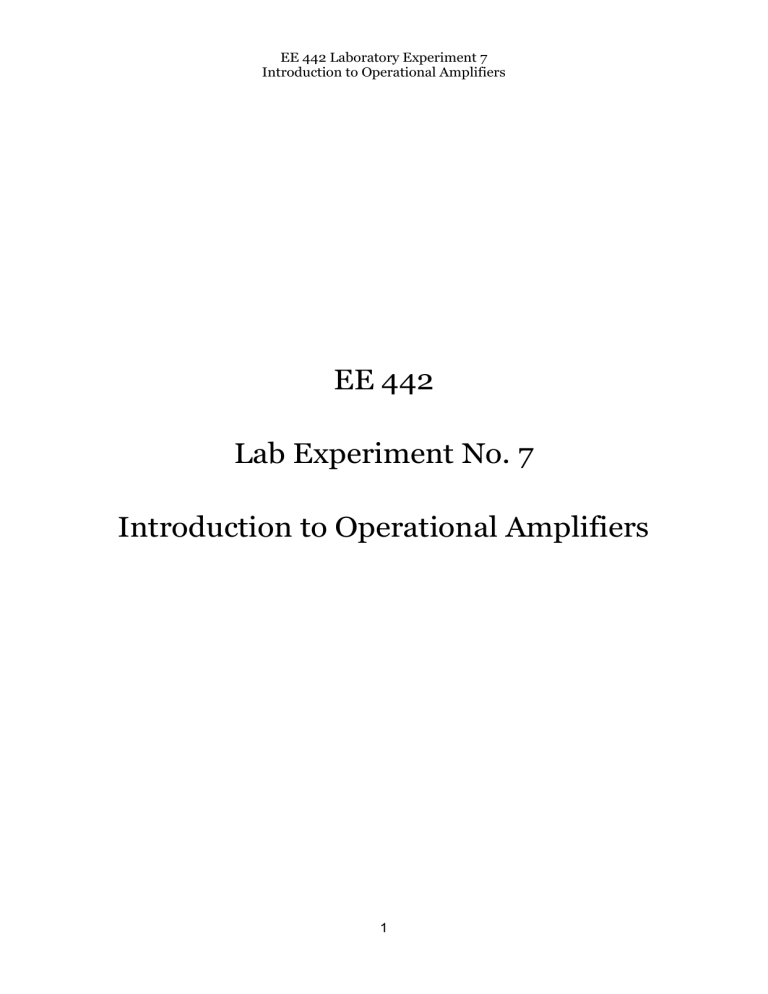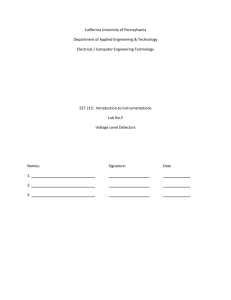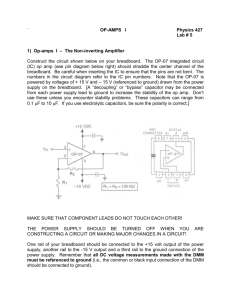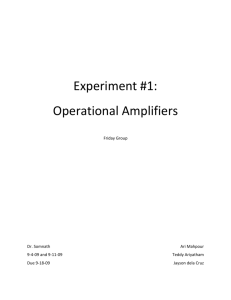442lab7

EE 442 Laboratory Experiment 7
Introduction to Operational Amplifiers
EE 442
Lab Experiment No. 7
Introduction to Operational Amplifiers
1
EE 442 Laboratory Experiment 7
Introduction to Operational Amplifiers
I. PURPOSE
The purpose of this experiment is to introduce the student to the μA741 operational amplifier (Op Amp) and to use it in four different circuit configurations:
1. An inverting amplifier
2. An inverting summing amplifier
3. An inverting integrator
4. An inverting differentiator
II.
INTRODUCTION
The μA741 operational amplifier, which will be used in this experiment, is available in a 14-lead DIP package, an 8-lead mini DIP package, an
8-lead round metal can package, and in other package configurations.
The 8-lead mini DIP configuration will be used in this experiment.
It is very important that the leads (or pins) of this device are connected correctly to other circuit components to ensure that the overall circuit operates properly to avoid damage to the Op Amp. The schematic symbol of an Op Amp is shown below (right). Included are the pertinent terminals which are numbered according to the manufacturer’s pin numbering system for a 14-lead DIP configuration.
This pin arrangement is also shown below (left) for the entire package as viewed from the top.
Pin 1 Offset Null (not used)
Pin 2 Inverting input (-)
Pin 3 Noninverting input (+) (2)
Pin 4 - Vcc (Negative supply)
Pin 5 Offset Null (not used) ()
Pin6 Output ()
Pin 7 + Vcc (Positive supply)
Pin 8 N.C. (Not Connected)
2
EE 442 Laboratory Experiment 7
Introduction to Operational Amplifiers
III. PRELIMINARY EXERCISE
Two of the four circuits to be examined in the experiment (the inverting amplifier and the inverting summing amplifier) have probably already been presented in the text and perhaps have been discussed in class. As part of the preliminary exercise, review the analytic process of solving for v
0
as a function of the circuit parameters (resistance values) and input voltage(s). Do this for the two circuits shown in parts A and B below.
After establishing a general relationship for v
0
find the corresponding specific expression using the parameter values given below each circuit.
Included on these circuit diagrams are the ±V supply voltages and the
8-lead mini DIP terminal identification numbers. These are not needed in the prelim calculations. They will be used in the performance part of the experiment.
A.
Inverting Amplifier
R2
Vin(t)
R1
2
-
-VCC uA741
OUT
6
3
+
+VCC
+
Vo(t)
-
Calculate an expression for v
0
(t) if:
V in
(t) = 1 sinω t Volts
Frequency = 1kHZ (approximately)
R
1
= 10kΩ
R
2
= 100kΩ
Result: Calculated v
0
=
B.
Inverting Summing Amplifier
3
+
V1
-
+
V2
-
+
V3
-
EE 442 Laboratory Experiment 7
Introduction to Operational Amplifiers
Rf
R1
R2
R3
2
-
-VCC uA741
OUT
6
3
+
+VCC
Calculate an expression for v
0
(t) if v = -15 VDC = +4.5 VDC =3 sinω t Volts
R
1
= 10kΩ
R
2
= l0kΩ
R
3
= 10kΩ
R f
= 10kΩ
Result Calculated v
0
(t) =
C. Inverting Integrator
Continue the preliminary exercise by finding an expression for v
0
(t) as a function of R in
,C f
, and v in
(t) for the integrator circuit below. This analysis can be done using the same basic techniques (and approximations) as for the circuits of parts A and B. A convenient step in the analysis is to introduce the variables and v c
and i c and make use of the corresponding v c
-i c relationship. Record your v
0
expression below.
Expression of v
0
(t) = .
Cf
+
Vo
-
Vin
Rin i-in i-c
2
-
+ Vc -
-VCC uA741
6
OUT
3
+
+VCC Vo
+
-
After obtaining the general expression for v
0
, use the following set of parameter values to calculate a specific v
0
(t) for the given
V in
(t). Note that the evaluation of v
0
(t) depends upon the
4
EE 442 Laboratory Experiment 7
Introduction to Operational Amplifiers corresponding value of V in
(t). v c
(0) =0
R in
= 10kΩ
C f
= .1 μF
V in
(t) = ±2 volt (4 volts peak—to—peak) square wave (shown below) frequency = 500 Hz
This calculation requires the integration of V in
(t) for one period of oscillation of V in
(t). Note T = 1/f =2 ms (and T/4 = 0.5 ms).
Sketch your resultant v
0
(t) on the coordinates provided. Label the voltage axis (with voltage values).
Calculated results:
D.
Inverting Differentiator
The next and last circuit to examine is an inverting differentiator, shown below. Derive an analytic expression for v
0
in terms of C in
,
R f
, and v in
, and record below.
Expression of v
0
(t) = .
5
Vin
EE 442 Laboratory Experiment 7
Introduction to Operational Amplifiers
Cin i-in
Rf i-f
2
-
+ Vc -
-VCC uA741
6
OUT
3
+
+VCC Vo
+
-
Next, determine a specific v
0
(t) waveform (to be sketched) corresponding to the triangular v in
waveform given below. Use the values of the circuit components, also specified below.
Calculate the v
0
(t) waveform over one cycle of the v in
(t) variation.
For studying this circuit we will use a frequency of 250 Hz. The period, therefore, is T =1/f = 4 ms. Sketch your resultant (t) waveform on the coordinates provided below. Label the voltage axis (with voltage values).
R f
= l0kQ
C in
=.01μF v in
= ±10 volt (20 volt peak—to-peak) triangular wave frequency = 250Hz
6
EE 442 Laboratory Experiment 7
Introduction to Operational Amplifiers
IV. PERFORMANCE
The performance part of this experiment consists of constructing each of the four circuits analyzed in the preliminary exercise, and then measuring the output voltage corresponding to the given set of input conditions for each circuit. For all measurements of Op Amp circuits using the CRO, set the input coupling selector switches on both channels to DC.
A ±V cc
voltage combination is required for proper operation of all Op
Amp circuits. These voltages must be connected to the appropriate pins
(numbers 4 and 7) on each Op Amp. This voltage combination is available, for Vcc = 12 volts, from the variable DC voltage supply unit by adjusting the +/- 20V output. Use a banana to banana connector to connect common to ground. The setup is shown in the figure below.
A. Inverting Amplifier
Construct the circuit configuration shown in part A of the prelim, where R
2
=l00kQ and R1 = 10KQ. v in
is the output terminal voltage of the function generator, adjusted to a 1 volt peak sinusoid, with a frequency of approximately 1 kHz. Using the
CRC in its dual trace mode of operation, observe v in
(t) and v
0
(t)
(simultaneously) and sketch v
0
(t) below. Label both voltage axes.
Using values of R2 and R1 calculate the theoretical voltage gain and record below. You will get more accurate results by using the measured (with DMM) values of these resistors rather than their labeled or color-coded (nominal) values. From waveform observations on the CRO, calculate the (experimental) voltage
7
EE 442 Laboratory Experiment 7
Introduction to Operational Amplifiers gain and record below. Voltage gain can be found from CRO measurements as the ratio:
Voltage gain of amplifier = (v
0
(peak-to-peak))/(v in
(peak-to-peak))
Compare these results with those of the preliminary exercise part A.
R1= ___________
R2= ___________
Theoretical
Voltage gain =
Experimental voltage gain =
B. Inverting Summing Amplifier
Construct the circuit configuration shown in part B of the prelim.
Note that the general expression of v
0
for this amplifier is a weighted sum of the input voltages where the weighting factors are resistance ratios. All the resistor values are nominally 10 kΩ.
Before connecting these in the circuit, measure each with the
DMM ohmmeter and record below. After measuring them, make the assignment as to which resistor is which in the circuit. The next step is to locate and establish the three input voltages. v
1
will be derived from a 1.5 volt flashlight battery. v
2
will come from the
DC supply, and v
3
will be derived from the function generator in its sinusoidal mode of operation.
R
1
= __________
R
2
= __________
R
3
= __________
R f
= __________
After making sure the DMM is adjusted to measure DC volts, measure the voltage of the flashlight battery, which should be about 1.5 volts. Connect the negative terminal of the battery to R
1 of the summing circuit. Next, adjust the voltage of the DC supply
8
EE 442 Laboratory Experiment 7
Introduction to Operational Amplifiers to 4.5 volts and connect its positive termina1 to R
2
. Now connect the CRO to the (sinusoidal) output of the function generator and adjust its peak amplitude to 3 volts (6 volts peak-to-peak). Use a frequency of about 1 kHz. Connect the positive terminal of the function generator to R
3
of the summing circuit. Then connect the other terminals of the three sources to the “common’’ node terminal of your amplifier. After all these connections are made, energize the ±12 volt Op Amp supply, and measure v
0
with the scope. Suggested scope settings are 1 VOLT/DIV, 0.2 ms/ DIV, and a zero volt trace line one major division down from the top of the graticule. Sketch the waveform you observe, below, and compare with the calculated expression of prelim part B.
C.
Inverting Integrator
Construct the integrating circuit shown below. This is different from the circuit analyzed in prelim part C. In the circuit below, the resistor R f
has been added in the feedback loop. R f
is introduced for practical reasons. It tends to keep the integrator from drifting into saturation due to charge accumulation on the capacitor. R f
is large enough that it does not enter into the calculations done in prelim part C.
9
EE 442 Laboratory Experiment 7
Introduction to Operational Amplifiers
100k
Vin(t)
10k
2
-
.1uF
-VCC uA741
OUT
6
3
+
+VCC
+
Vo(t)
-
As in the prelim, V in
is a 4 volt peak-to-peak (± 2V) square wave with a repetition rate (frequency) of 500 Hz. Set these conditions on the function generator and then connect V in
to
CH1 of the CRO. Connect CH2 of the scope to the v
0
output signal of your circuit. This allows dual trace operation, so both v
0 and V in
signals can be observed simultaneously. Another reason to use CH2 to view v
0
is that you can now un-invert the inverted
(integral) v
0
waveform. If you want to do this (optional), push the CH2 invert button. Sketch the v
0
waveform you observe, relative to V in
on the coordinates below. Compare the shape of the observed v0 waveform with that calculated in the prelim. It should be triangular, representing the integral of a square wave.
Be sure to account for the CH2 invert, if used.
Experimental observations:
CH2 invert button:
In
Out
10
EE 442 Laboratory Experiment 7
Introduction to Operational Amplifiers
D.
Inverting Differentiator
Construct the inverting differentiator circuit shown below.
10k
Vin(t)
0.01uF
2
-
0.001uF
-VCC uA741
OUT
6
3
+
+VCC
+
Vo(t)
-
This circuit differs from that in the prelim due to the addition of the .001 μF capacitor in the feedback loop. This capacitor is practical necessity, as was the 100 kΩ resistor in the integrator circuit. It is needed to eliminate oscillations in the waveform of the output signal due to (Op Amp) circuit instabilities at high frequencies. These oscillations appear in the output waveform at the same values of time as discontinuities in the derivative appear in the input waveform (i.e. at the peaks of the triangular wave). This capacitor is of such a value (with respect to the frequency of operation) that it has no effect on the results of the calculations done in prelim part D.
As mentioned in the prelim, V in
is a 20 volt peak-to-peak triangular wave with a frequency of 250 Hz. As with the integrator study, it is important that the frequency of the function generator be accurately set. Connect CHI to V in
and CH2 to v
0
(dual trace operation). v
0
should appear as a square wave,
11
EE 442 Laboratory Experiment 7
Introduction to Operational Amplifiers representing the inverted derivative of V in
. The inverted aspect of this signal can be removed by pushing the CH2 INVERT button.
Compare this result with the corresponding calculated version of v0 done in the prelim. Pay due regard to the position of the invert button. Sketch the observed v
0
waveform on the coordinates below.
Experimental observations:
CH2 invert button:
In ___________
Out__________
12







